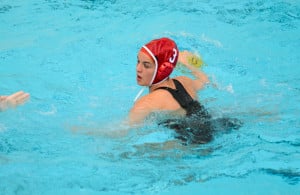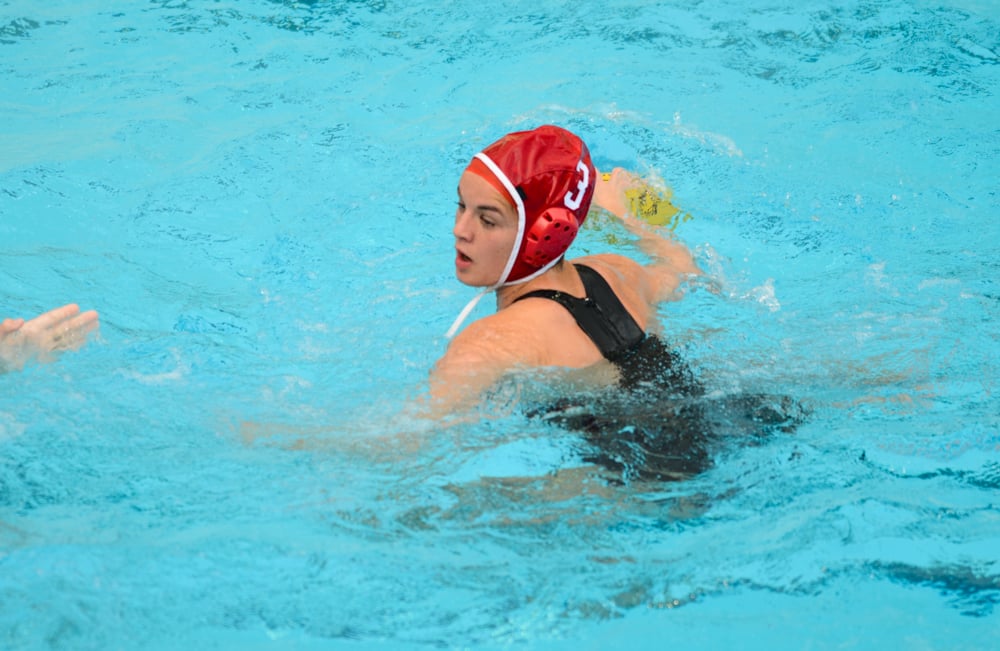You would be hard-pressed to find a more decorated and successful Stanford Athletics program over the past few years than women’s water polo.

Stanford women’s water polo has been to four straight national championship games. It has won two of the last three national titles. This year, it had seven players named to all-conference teams. Two of its top players won gold medals for the United States at the London Olympics in 2012, including leading scorer and Olympic MVP Maggie Steffens, a current sophomore. The team has finished the last five regular seasons ranked No. 1 in the nation.
Yet, despite all the accolades, one achievement seemed to always escape the Card: the Mountain Pacific Sports Federation (MPSF) conference title. Even with its pair of national titles, Stanford had not won its conference title since all the way back in 2006.
Last year, it was USC who took down the No. 1 Cardinal in the MPSF title game, as the Trojans jumped ahead early by five goals. In 2012, UCLA upset top-seeded Stanford in overtime of the MPSF title game at Avery Aquatics Center, snapping the Cardinal’s 37-game home winning streak. And again, in 2011, the undefeated Card dropped their first game of the season in the semifinals of the MPSF Tournament to No. 4 UCLA. For the past seven seasons, the MPSF Tournament — and the Bruins in particular — had not been kind to Stanford; UCLA knocked Stanford out in four of those seven tournaments.
That all changed just over a week ago, however, when the top-ranked Cardinal fittingly defeated No. 2 UCLA 6-5 in a thrilling comeback victory to capture that elusive MPSF title for the first time since 2006. After trailing 5-3 at halftime, Stanford shut out UCLA the rest of the way, scoring the final three goals and thus finishing the MPSF Tournament with a resounding statement.
“It shows that we have resilience,” said junior Kiley Neushul, who leads the team in scoring and was recently named to the All-MPSF first team. “We didn’t get lazy before the NCAA Tournament. My freshman year, I felt that we powered through that tournament and UCLA actually beat us fairly — we played a strong game against them. My sophomore year, it was lackadaisical, like we didn’t care about the MPSF and we were only looking at one goal. This year, we’re more focused on every game and every possession.”
While the MPSF Tournament had no postseason implications, as the Cardinal would easily have received a wild card berth into the NCAA Tournament even if they had lost, it did provide a unique training experience with games on back-to-back days against stellar competition. Additionally, the added bonus for this year’s tournament was that it took place at USC’s new Uytengsu Aquatics Center, which will also serve as the site for the upcoming NCAA Tournament this weekend.
“I think the opportunity to play at USC for the first time in that new pool and be the first to win an MPSF championship there was really fun for us, and gave us a tool to have in our back pocket,” Steffens said.
Historically, the MPSF has been by far the country’s most difficult conference to play women’s water polo. For five straight years, all at-large bids to the NCAA Tournament have come from MPSF teams. The last 13 women’s water polo national champions are from the MPSF. To win the MPSF Tournament is arguably just as difficult as winning the NCAA Tournament.
“It’s one of those things that you look back on and say, ‘You know, this is a great conference, but we’ve won the regular season title a couple of times,’” said head coach John Tanner. “It was fun to go down there and put two really good games together. As much as anything, we just haven’t done that before or in a while.”
In recent years, the MPSF has become even stronger. The top five teams in the NCAA Tournament this season hail from the MPSF — Stanford, UCLA, USC, Cal and Arizona State. The Sun Devils made the tournament this year for the first time in program history, and if there was one more at-large bid, it likely would have gone to fellow MPSF team San Jose State, which went 20-13 overall and 2-4 in conference play only a year after finishing 14-11 overall and 1-8 in conference play. Winning the conference tournament was no small feat for the Cardinal.
“At the end of the day, the MPSF championship isn’t as important as the NCAA championship, but the fact that we were able to win that tight game against UCLA and have a very good semifinal makes our team stronger,” Neushul said. “Moving forward, having those games under our belt where we performed during a pressure situation will be very beneficial.”
Ultimately, the goal for the Cardinal lies beyond the MPSF Tournament, but it certainly showcased why this year’s team might be more prepared than ever to make another run at a national championship. Not only does the team possess superior talent and the confidence from the MPSF Tournament win, but the Card also enter this weekend’s NCAA Tournament still driven by memories of last year’s national championship defeat.
“I was grateful to have the opportunity to play in the national championship and for our team to play in the national championship, but there’s nothing like having that loss,” Steffens said of last year’s loss. “The feeling of being so close to something and not being able to get it, it’s definitely motivation.”
“So close” might be an understatement in describing last year’s national championship. Stanford and USC squared off for the fourth time all season to produce the longest NCAA title game in women’s water polo history, which lasted four overtimes. Despite holding a 4-3 halftime advantage, the Cardinal fell when USC’s Anni Espar scored the golden goal with 13 seconds left in the fourth overtime.
With the motivation from last season’s end result, the Cardinal completed a season this year that also has them primed for the grind of the NCAA Tournament. At 22-1, the Cardinal have won 13 straight games after losing in the UCI Invitational to UCLA, including two wins over UCLA and a win over then-No. 1 USC.
Spurring that success has been a balanced team approach. For only the second time since 2006, Stanford had four players (Neushul, Steffens, junior Ashley Grossman and senior Annika Dries) score over 40 goals, showcasing the team’s incredible depth and diversity in attack.
“I think that the depth of our team allows us to go full force when we’re in the water,” Steffens said. “It allows us to give everything we have in the water, and if we need a sub, there’s no lack of game, it keeps going strong. I think that’s something that teams can take for granted sometimes.”
“[The depth] shows up in different ways and on different weekends,” Tanner added. “We may get somebody in foul trouble who plays some position and it’s sort of the next person up who has stepped in and done really well. That’s been rewarding.”
Stanford’s depth proved extremely valuable when senior driver Kaitlyn Lo was injured and forced to sit out of the lineup for two and a half months. Lo had scored over 25 goals in each of the past two seasons, and was expected to be an integral part of this year’s team.
Part of the reason for the emergence of the team’s depth this year stems from the competitiveness exhibited by the team during practices. Whether it’s Sunday morning or Wednesday afternoon, practices are fueled by the energy every team member has brought on a daily basis.
“We had a string of practices this year that were insanely good, better than any practices I’ve ever had at Stanford before,” Neushul said. “It’s tough to get yourself away from your work or up from a nap to go to practice. But when you can do that and show up for the team and for your girls, it shows a lot.”
The competitiveness of practices has guided not only the freshmen that know nothing else, but also the upperclassmen, who must fight just to prove themselves and earn playing time on a deep roster. The veterans have more than risen to the challenge.
“Day in and day out we’ve had competitive workouts,” Tanner said. “And that’s what depth does for you. But it’s also a competitive attitude and people have shown up each day ready to compete…And that’s what’s fun about being at Stanford. It seems like that’s a component of life here.”
Tomorrow, Stanford officially begins the quest to take home another national championship and in the process, move past last season’s echoes.
“It’s a tightening of focus and realizing that it’s go time,” said Dries, who also played for the U.S. Olympic team in 2012. “It’s being the aggressors. We might be the No. 1 seed, but we are still very hungry from last year, and I think that’s something that has carried our team a long way.”
After the Cardinal men’s volleyball team fell just short of a national title in last week’s 3-1 championship defeat to Loyola Chicago, Stanford is still seeking a national championship for a 38th consecutive season. The women’s water polo team would love nothing more than to be the ones to bring Stanford that distinction.
“There’s a sense of pride that accompanies wearing the ‘S’ on your chest, and that pride can take you a long way, and that’s motivation in itself,” Steffens said. “Just knowing that the school is behind us and cheering for us, and having [last year’s] loss in the back of our mind will definitely be the motivation when we…can’t breathe and need that extra push.”
Stanford will face Indiana on Friday in the first round of the NCAA Tournament, followed by either Cal or Arizona State on Saturday if the Cardinal win. Advancing to the championship would likely pit the Cardinal against one of two MPSF rivals, UCLA or USC. Whoever the Cardinal face throughout the tournament will bring a deep team with lessons learned from this season, motivated by their own drive as well as the pride of a university.
“There’s a lot of parity, and it’s really hard to tell how things will play out,” Tanner said. “We’re just focused on us and getting to play at a high level on Friday. We will see how it unfolds after that.”
Contact Michael Peterson at mrpeters ‘at’ stanford.edu.
